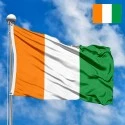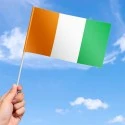The national flag of the Republic of Côte d'Ivoire, often referred to as the Ivorian flag, is a vibrant tricolor that stands as a proud emblem of the nation's independence, its deep connection to the land, its people, and its aspirations for a prosperous future. Adopted on December 3, 1959, just before the country gained full independence from France on August 7, 1960, the flag's design is a powerful statement of national identity and a hopeful vision for a sovereign Côte d'Ivoire. It embodies the spirit of a young nation charting its own course.
Design and Symbolism: A Palette of National Values
The flag of Côte d'Ivoire is a vertical tricolor, featuring three equally wide stripes of orange, white, and green. Each color holds profound meaning, reflecting the country's unique heritage and its national principles:
-
Orange (Hoist Side): The leftmost stripe, positioned at the hoist (flagpole) side, is a vibrant orange. This color represents the savannas of the north of the country and their richness, symbolizing the fertility of the land and the national spirit of growth and development. More abstractly, it also stands for the blood of the youth shed in the struggle for emancipation, and the generosity of the Ivorian people. It evokes the warmth, welcome, and hospitality that are characteristic of the nation.
-
White (Center): The central stripe is pure white. This color unequivocally symbolizes peace, purity, and unity. It represents the peace achieved through independence, the purity of purpose in building a new nation, and the unity of all Ivorians, regardless of their ethnic or regional background. It is often interpreted as the meeting point between the north (orange) and the south (green), emphasizing the crucial role of harmony and understanding in a diverse nation.
-
Green (Fly Side): The rightmost stripe, at the fly (outer) side, is a deep green. This color represents the forests of the south, which are a significant natural resource of Côte d'Ivoire. Beyond its natural symbolism, green also signifies hope, prosperity, and the future. It reflects the nation's faith in a bright future, its rich natural wealth, and the determination to achieve economic development and sustainability.
The vertical arrangement of these colors, resembling the French Tricolour but with distinct Ivorian hues and meanings, highlights the historical ties to France while firmly asserting Côte d'Ivoire's unique identity. The sequence itself, from the dry north (orange) through unity (white) to the lush south (green), forms a visual narrative of the country's geography and national aspirations.
Dimensions and Proportions:
The official proportions of the Flag of Côte d'Ivoire are a width-to-length ratio of 2:3. This is a standard and common ratio for many national flags worldwide, ensuring visual balance and ease of manufacture. The three vertical stripes are of equal width, meaning each stripe occupies exactly one-third of the flag's total length. This equal division reinforces the idea of balance and equal importance of the values represented by each color. The design's simplicity and clear proportions make it instantly recognizable and impactful.
History and Evolution: A Symbol Born of Independence
The history of the Ivorian flag is relatively short but deeply intertwined with the nation's journey to independence from colonial rule.
-
Colonial Era: Prior to its independence, Côte d'Ivoire, as a French colony, used the French Tricolour (blue, white, red) as its official flag. There were no distinct regional flags with official status during this period.
-
Road to Independence and Federation: In the mid-20th century, as African nations moved towards self-governance, a desire for distinct national symbols grew. Côte d'Ivoire was part of the French Community and the short-lived Conseil de l'Entente, a regional economic and political alliance.
-
Adoption of the Flag (1959): The flag was officially adopted on December 3, 1959, just a few months before Côte d'Ivoire gained full independence. The design was chosen to reflect the new nation's identity and aspirations. The inspiration for a vertical tricolor came from the French flag, symbolizing the historical link, but the choice of orange, white, and green was distinctly Ivorian. Orange was chosen over red to symbolize the savanna and the blood of the youth, distinguishing it from revolutionary connotations. Green symbolized the forests and hope, and white remained for peace and unity. This decision was a powerful statement of self-determination.
-
Independence (1960): On August 7, 1960, Côte d'Ivoire achieved full independence, and the newly adopted flag became the supreme national emblem. It has remained unchanged since, a consistent symbol of national unity and sovereignty. The flag's creation marked a pivotal moment, signifying the end of colonial subjugation and the dawn of a new era of self-rule.
The flag represents not just the political independence of Côte d'Ivoire but also the broader pan-African movement towards self-determination and the unique identity of the Ivorian people within that larger narrative.
Regional Context and West African Identity:
Côte d'Ivoire is located in West Africa, bordering Liberia, Guinea, Mali, Burkina Faso, and Ghana. Its flag, with its vertical orange, white, and green stripes, bears a striking resemblance to the national flag of Ireland (green, white, orange vertical stripes). While visually similar, their origins and symbolism are entirely distinct. This similarity can sometimes lead to confusion, but it is purely coincidental.
Within the West African context, Côte d'Ivoire's flag is often compared to that of Niger (horizontal orange, white, green with a central orange disc). Both flags share the same three colors, reflecting common geographical and cultural themes (savanna, peace, agricultural wealth). However, the vertical orientation and the specific order of colors make the Ivorian flag unique. Many West African flags also incorporate Pan-African colors (red, yellow, green) or refer to specific liberation movements. Côte d'Ivoire's flag, while not explicitly Pan-African in its color symbolism, nonetheless embodies the spirit of independence and national aspiration common to the region. Its design reflects a specific national identity rooted in its geography and the aspirations of its people, rather than a broader regional ideology. The flag stands as a testament to Côte d'Ivoire's sovereign identity within the diverse West African mosaic.
Interesting Facts:
-
Near Identical to Ireland's Flag: The flag of Côte d'Ivoire is almost identical to the flag of Ireland, with the colors reversed. Ireland's flag has green, white, and orange, while Côte d'Ivoire's has orange, white, and green. This is a common source of confusion but is purely coincidental, as their historical origins and symbolism are entirely unrelated.
-
Inspired by the French Tricolour: The vertical stripe format was inspired by the French flag, a nod to its colonial past, but the colors and their meanings are uniquely Ivorian.
-
"Land of Gold" vs. "Ivory Coast": The country's name, "Côte d'Ivoire," translates to "Ivory Coast," reflecting its historical significance as a major ivory trading hub. The flag, however, doesn't feature direct ivory symbolism, instead focusing on broader national values.
-
Symbol of National Unity: The white stripe, symbolizing peace and unity, is particularly significant in a nation that has experienced periods of internal conflict, highlighting the importance of reconciliation.
-
Designed for Independence: The flag was adopted in 1959, even before full independence in 1960, demonstrating the nation's readiness and determination to forge its own path.
-
Not Pan-African Colors: While many African flags adopted red, yellow, and green (Pan-African colors), Côte d'Ivoire chose a distinct palette reflecting its specific geography and aspirations.
-
Geographical Representation: The orange represents the northern savanna, and the green represents the southern forests, making the flag a geographical map of the country.
-
Flag of the Conseil de l'Entente (Historical Context): At the time of its adoption, Côte d'Ivoire was part of the short-lived Conseil de l'Entente, an economic and political union of West African states. While the Conseil had no single flag, Côte d'Ivoire's flag uniquely represented its vision.
-
Consistent Design: Unlike some nations that have changed their flags multiple times, the Ivorian flag has maintained its original design since its adoption, showcasing stability and continuity.
Significance for the Inhabitants: A Proud Banner of Identity and Aspiration
For the people of Côte d'Ivoire, their national flag is a source of profound pride and a powerful daily reminder of their hard-won independence, their rich cultural tapestry, and their shared aspirations for the future. It is more than just a piece of cloth; it is a living symbol that embodies their collective journey, their resilience, and their unwavering hope.
The orange stripe resonates deeply with the spirit of the Ivorian people – their warmth, generosity, and the vibrant energy of the northern savannas. It evokes the fertility of their land and the promise of growth and development, reminding them of their agricultural heritage and the potential for a prosperous future. The white stripe, central to the flag, is arguably the most crucial element for a nation that has endured periods of political turbulence. It serves as a constant plea and a guiding principle for peace, unity, and purity of purpose. For many Ivorians, it is a daily affirmation of the need for reconciliation and national cohesion, symbolizing the coming together of diverse communities.
The green stripe represents the lush southern forests, the country's abundant natural resources, and the deep-seated hope for economic prosperity and sustainable development. It signifies the nation's faith in its future, its commitment to protecting its environment, and its determination to build a better life for all its citizens.
Together, these colors and their arrangement tell the story of Côte d'Ivoire – a nation of diverse regions united by a common desire for peace and prosperity. The flag is displayed with reverence during national holidays, sporting events, and in homes and public spaces, fostering a strong sense of national identity and solidarity. It symbolizes the Basotho people's pride in their heritage, their commitment to self-determination, and their collective optimism for a harmonious and thriving nation. It is a powerful emblem that binds them together, urging them to work towards the realization of the ideals it so beautifully represents.
In the demonstration images, full-size flags are shown with proportions of 2:3, and hand-held flags with proportions of 1:2.






 Waving flag
Waving flag
 Sizes:
Sizes:
 Round flag
Round flag
 Sizes:
Sizes:
 Rectangular flag 2:3
Rectangular flag 2:3
 Sizes:
Sizes: